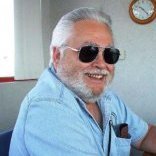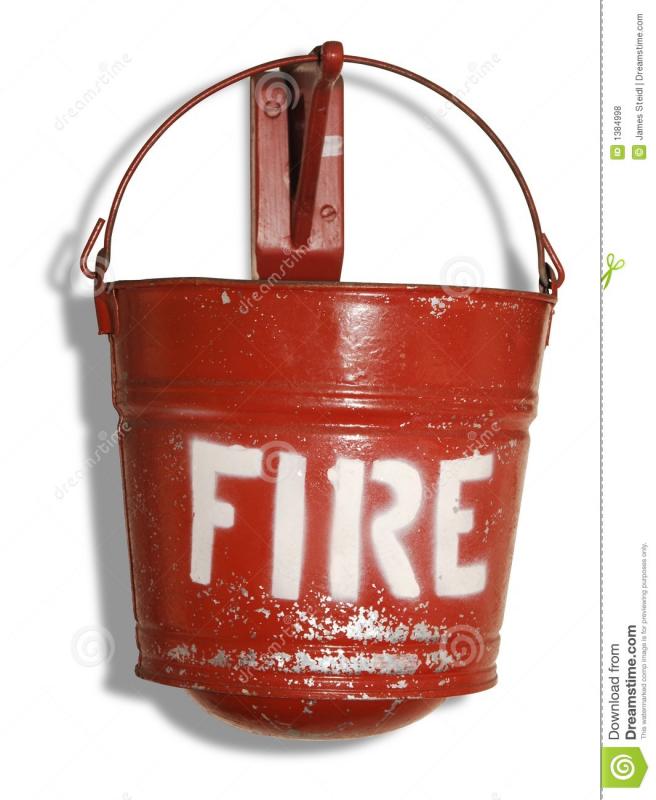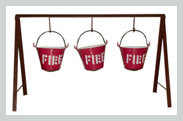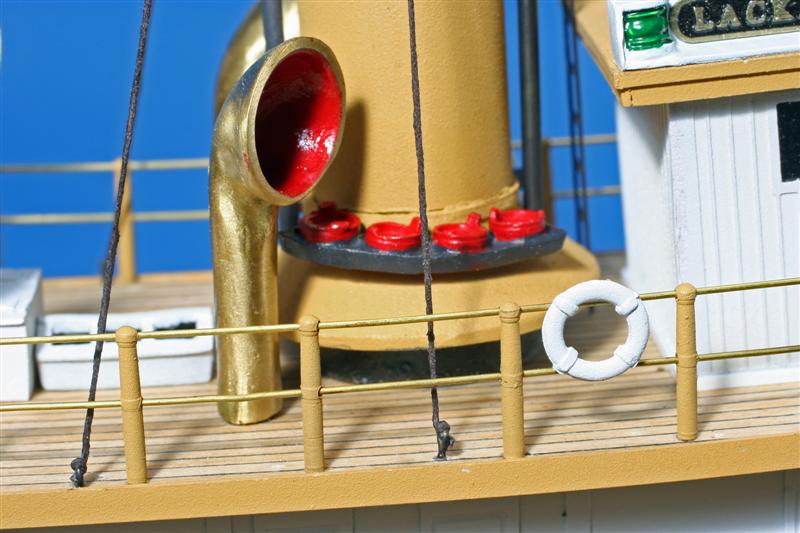-
Posts
3,039 -
Joined
-
Last visited
Content Type
Profiles
Forums
Gallery
Events
Everything posted by kurtvd19
-
99.9% of dowels supplied in kits are great for use in the garden to hold up small plants. The 0.1% are the straight ones. Best to use square stock and make it round using small planes - also easier to do the flat areas when you start with flat stock. Best way to avoid ever having the mast warp is to glue up 4 pieces into square stock and work from there. First step in making it round is to knock off the 4 corners making it 8 sided - leave the 8 sided part alone at the proper area and round off the rest of the mast. Just my opinion and Dennis Miller and I might both be wrong... Kurt
-
Mike: It has really turned out nice. A very good model. The term for the planky, boarding rampy sort of thing is landing stage. And you did a good job on it too - wasn't that fun to rig into place? Kurt
- 225 replies
-
- chaperon
- model shipways
-
(and 1 more)
Tagged with:
-
Mike: I like your boats. Nice job on the planking. You took it beyond what I did with the ones from mt build. Kurt
- 225 replies
-
- chaperon
- model shipways
-
(and 1 more)
Tagged with:
-
Mike: Yeah, the fire buckets sit in a rack with a hole in the top board to hold the buckets upright. Sometimes they hung buckets from brackets or stands. The photo of my model of the Bluejacket kit of the tugboat Lackawanna shows fire buckets in the rack at the base of the stack. Sorry, being a retired FD Chief I assumed everybody just knew this. Kurt
- 225 replies
-
- chaperon
- model shipways
-
(and 1 more)
Tagged with:
-
Mike: The planks of the wheel are called Bucket Boards. I don't know if that term was used in the kit instructions or not but it's common usage. When you mentioned a bucket for water, one thing I meant to add to the model and never got around to it was a couple of racks of fire buckets carried on the roof of the boat to stop fires started by sparks from the stacks. I don't remember if these were included in the kit or not. They might have been included in the kit and I didn't use them because they most likely had flat bottoms as the kit pieces usually have - fire buckets had round bottoms - and were painted red. The round bottoms were to make them useless for anything else so the crew would know they were where they were supposed to be and not being used to swab decks or something. Kurt
- 225 replies
-
- chaperon
- model shipways
-
(and 1 more)
Tagged with:
-
Chris: Use the piece of wood that surrounds the laser cut keel piece as the "scrap" it is the same thickness and is big enough to allow practice. Did you know that BB rode a Gold Wing to (at least some) of the Harley events he covered for the magazine? Ran into him at both a Harley meet and at the Newport RI Yacht Show (when he covered it for Attitudes and Latitudes) and stopped at our tent. Kurt
- 54 replies
-
- glad tidings
- model shipways
-
(and 1 more)
Tagged with:
-
Mike: Looking Good! I like the dark buckets - good contrast.
- 225 replies
-
- chaperon
- model shipways
-
(and 1 more)
Tagged with:
-

Galley Washington by Mike40 - 1:48 - POF
kurtvd19 replied to Mike40's topic in - Build logs for subjects built 1751 - 1800
The only thing that's going to change is the scale of the cut-offs that you will be saving. It's amazing how many will wind up being used someplace on some model. Will be watching. Thanks, Kurt -
I anybody wants to get some of the discontinued Dockyard Micro Chisels I saw a bunch at a wood show this past weekend from a shop in Bettendorph, IA. I bought a bunch of rotary carving bits from them at very reasonable prices. They had the Dockyard tools on display and they are still shown on their web site. http://www.thewoodcraftshop.com There is also a nice dedicated strop for sharpening these tools with all of the curves and angles. Kurt
-
Mike: It's looking great. The pilothouse work is right on! Kurt
- 225 replies
-
- chaperon
- model shipways
-
(and 1 more)
Tagged with:
-
The only thing magical about that tool is it's ability to steal money year after year from unsuspecting modelers. Kurt
-
OC Test the same combination off the model. The Rustoleum problem was tested with many different paints over it with the same results - the color coats failed to cure/dry - enamels, and acrylics. Maybe they have changed again - that's the problem, they seem to change quite often with poor results. They may have solved the problem, but too late for me to ever try them again. And I can assure you somebody is reading this thread and saying we are nuts that they have never had a problem - and they probably didn't have one - yet. If it tests OK on similar materials in the same layering sequence then it's OK - but test off the model first. Kurt
- 68 replies
-
- Arleigh Burke
- BlueJacket Shipcrafters
-
(and 1 more)
Tagged with:
-
Stay away from Rustoleum. They have changed their formulation and all sorts of bad stuff happens when you put any thing else on it - even acrylics. I will never have Rustoleum in the shop again nor will several other guys I know who learned the hard way. Kurt
- 68 replies
-
- Arleigh Burke
- BlueJacket Shipcrafters
-
(and 1 more)
Tagged with:
-
Be careful of the You Tube videos as some are excellent and others are absolutely horrible and one can get far off track if one of the bad ones is followed. Once you are a bit experienced you can tell the good from the bad but until then sample a bunch to see if there is any agreement between them. Kurt
-
We had a bent hull structure that was used as an example of what not to do, that had been planked on one side and then the other, shown at a NRG Symposium. It had a very visible curve that would never be corrected w/o removing all of the planking. I was surprised that anybody would proceed with the planking of the second side - obviously this was from a modeler with out a club or other input that blindly followed the instructions "plank the hull". Dave is correct that with the blocks added between bulkheads this could not happen as the blocks essentially turn the keel/bulkhead assembly into a solid hull. Kurt
-
Jack: Practice with two pieces of flat stock with some flux and Stay-Brite. Set them end to end with one piece overlapping the other - with the flux between the two pieces where they overlap with just a bit of squeeze out at the end of the piece on top and some small bits of the solder atop the flux right at the joint. Heat the brass where it is two layers thick just a bit back from where it overlaps. When the brass gets hot enough the flux will melt and shortly after that the solder should flow. When it flows remove the heat - the job is done at that point and heating it longer will hurt the joint. Let it cool a bit, use a pliers or tweezer to pick up the part and dip it in water. You should have a good joint. Once you see the solder melt and know what to look for you should be good to go. Remember the solder will flow to the heat. If the solder balls up you got it hot before the metal. Hope this helps. Take care, Kurt
- 250 replies
-
- willie l bennett
- model shipways
-
(and 1 more)
Tagged with:
-
Glen: I sure wish I had been with Mitch when he visited the INA and your shop the other day. It would have been great to see you and Kevin again - and these two models in person. Mitch told me just how cramped the model shop is with both of the models taking up most of the floor space. I understand he had to borrow your optivisor to see the end of the ball mills you used to do the doors and that he's really sort of taking your word that there is actually a ball at the tip of the mill. Kurt
-
Mike: It's looking good. Alignment can be a bear but in the end it all fits together quite well. Kurt
- 225 replies
-
- chaperon
- model shipways
-
(and 1 more)
Tagged with:
-
Ken: Glad you got to see the ship. It was supposed to be one of the NRG Conference visits while in San Diego next week - planned long ago but they moved up their touring dates and it will not be in San Diego next week. Love the foggy photos. And the canopy brass work is fabulous I am sure those at the conference next week will be looking it over closely. Kurt
-

Can i live without a BYRNES TABLE SAW
kurtvd19 replied to shihawk's topic in Modeling tools and Workshop Equipment
Bill: I am not sure that this article is in SN2 or not. I took it from the CD set - easier to find. But, the Shop Notes are sure filled with good tips. Kurt -

Can i live without a BYRNES TABLE SAW
kurtvd19 replied to shihawk's topic in Modeling tools and Workshop Equipment
The method I described for sharpening the blades was printed as a Shop Note (Vol 49.3 - page 176-177). I have attached a PDF of the Shop Note. The NRG publishes collections of Shop Notes from the Journals. Shop Notes 2 is currently available at the NRG Store on the web site. The original Shop Notes has been out of print for a few years but is being republished soon. Kurt SAW BLADE SHARP - P.pdf -
Jack: I am not familiar with the paste fluxes you mention but both should work. The Worthington would be my first pick to try as the Stay-Brite is lead free. I used the flux that came with the Stay-Brite for years until I ran out and tried some paste flux I had in the shop and liked the way it can be applied in just the right spot w/o running and then the small chips of solder can be placed right onto the flux and it stays in place w/o sliding off. Sounds like the Weller unit should work - the parts aren't very big so should heat up OK. Give it a try - on scrap pieces. Kurt
- 250 replies
-
- willie l bennett
- model shipways
-
(and 1 more)
Tagged with:
-
If you can get at all the joints the emery paper works fine. I use heated Sparex in a small croc pot to clean the parts before and after soldering. Either way, clean the residue off and then wipe with alcohol. Don't touch the joint area with your bare hands and use a good flux - I like to use a paste flux - as the bits of solder stick to it better than the liquids. Heat the joint until the solder flows and then back the heat off immediately. The joint should be good. I have used a Smith Little Torch for several years and it does a great job as the heat can be varied by the size tip used. I have started to use a resistance soldering unit in the last year and like it a lot. You can certainly use one of the larger soldering irons with the Stay-Brite but the pencil types probably will not heat the metal enough. Remember to heat the metal, not the solder. The solder will melt and flow to the heat. If able heat the back side of the joint with the solder on the face and the solder will flow into the joint. Kurt
- 250 replies
-
- willie l bennett
- model shipways
-
(and 1 more)
Tagged with:
-
Actual silver soldering isn't needed. Try Stay-Brite a silver bearing solder that melts at a much lower temp than silver solder but higher than soft solder. It can be blackened unlike soft solder and is plenty strong enough for the job. Parts need to be clean and adjacent joints need to be protected from getting too hot - heat sinks or clay as a heat sink around the previous joint do the job. Kurt
- 250 replies
-
- willie l bennett
- model shipways
-
(and 1 more)
Tagged with:
-

Can i live without a BYRNES TABLE SAW
kurtvd19 replied to shihawk's topic in Modeling tools and Workshop Equipment
David is referring to a method of removing every other tooth on the slitting blade and then filing an angle on the face of each remaining tooth with alternating angles from one tooth to the next. Only on the face of the tooth and no set to the teeth. This was developed by Lloyd Warner of Warner Woods West - and former NRG Chairman - who did this for all his saw blades that he uses to gang cut strips on a custom made saw with multiple blades. The advantage is no binding because the blades don't heat up from the sawdust not being able to be carried away in the cutting process. Bob Filipowski with Lloyd's permission developed a great Power Point presentation that he has shown at a NRG Conference as well as at local club meetings. I will check to see if this was written up in the NRG Shop Notes 2 book. Kurt
About us
Modelshipworld - Advancing Ship Modeling through Research
SSL Secured
Your security is important for us so this Website is SSL-Secured
NRG Mailing Address
Nautical Research Guild
237 South Lincoln Street
Westmont IL, 60559-1917
Model Ship World ® and the MSW logo are Registered Trademarks, and belong to the Nautical Research Guild (United States Patent and Trademark Office: No. 6,929,264 & No. 6,929,274, registered Dec. 20, 2022)
Helpful Links
About the NRG
If you enjoy building ship models that are historically accurate as well as beautiful, then The Nautical Research Guild (NRG) is just right for you.
The Guild is a non-profit educational organization whose mission is to “Advance Ship Modeling Through Research”. We provide support to our members in their efforts to raise the quality of their model ships.
The Nautical Research Guild has published our world-renowned quarterly magazine, The Nautical Research Journal, since 1955. The pages of the Journal are full of articles by accomplished ship modelers who show you how they create those exquisite details on their models, and by maritime historians who show you the correct details to build. The Journal is available in both print and digital editions. Go to the NRG web site (www.thenrg.org) to download a complimentary digital copy of the Journal. The NRG also publishes plan sets, books and compilations of back issues of the Journal and the former Ships in Scale and Model Ship Builder magazines.





